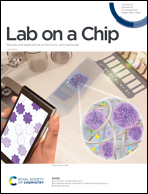Quantitative design strategies for fine control of oxygen in microfluidic systems†
Abstract
Hypoxia, or low oxygen (O2) tension, is a central feature of important disease processes including wound healing and cancer. Subtle temporal and spatial variations (≤1% change) in the concentration of O2 can profoundly impact gene expression and cellular functions. Sodium sulfite reacts rapidly with O2 and can be used to lower the O2 concentrations in PDMS-based tissue culture systems without exposing the cell culture to the chemical reaction. By carefully considering the mass transfer and reaction kinetics of sodium sulfite and O2, we developed a flexible theoretical framework to design an experimental microfluidic system that provides fine spatial and temporal control of O2 tension. The framework packages the dimensions, fluid flow, reaction rates, concentrations, and material properties of the fluidic lines and device into dimensionless groups that facilitate scaling and design. We validated the theoretical results by experimentally measuring O2 tension throughout the experimental system using phosphorescence lifetime imaging. We then tested the system by examining the impact of hypoxia inducible factor-1α (HIF-1α) on the proliferation and migration of MDA-MB-231 breast cancer cells. Using this system, we demonstrate that mild constant hypoxia (≤4%) induces HIF-1α mediated functional changes in the tumor cells. Furthermore, slow (>12 hours), but not rapid (<1 hour), fluctuations in O2 tension impact HIF-1α mediated proliferation and migration. Our results provide a generalized framework for fine temporal and spatial control of O2 and emphasize the need to consider mild spatial and temporal changes in O2 tension as potentially important factors in disease processes such as cancer.



 Please wait while we load your content...
Please wait while we load your content...